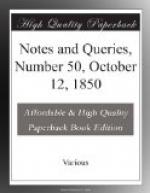“Per baculi formam
Praelati discite normam.”
In the first prayer-book of the Reformed English Church, 2 Edward VI., at the time of the holy communion the bishop is directed to have “his pastoral staff in his hand, or else borne by his chaplain.” It was used in solemn benedictions; and so lately as at the coronation of Queen Elizabeth. The second book of King Edward VI., published A.D. 1552, being revived in that reign, the use of the staff was discontinued, as we find by the consecration service of Archbishop Parker.
“Postq’ haec dixissent, ad reliqua Communionis solemnia permit Cicestren. nullu. Archie’po tradens Pastorale baculum.”—Bramhall, vol. iii. p. 205., Part i. Disc. 5. App., Oxon. 1844.
A crozier was borne at the funerals of Brian Duppa, of Winton, A.D. 1662; Juxon of London, 1663; Frewen of York, 1664; Wren of Ely, 1667; Cosin of Dunelm, 1671; Trelawney of Winton, 1721; Lindsay of Armagh, 1724. It is engraven on the monuments of Goodrich of Ely, 1552; Magrath of Cashel, 1622; Hacket of Lichfield, 1670; Creggleton of Wells, Lamplugh of York, 1691; Sheldon, 1677; Hoadley of Winton, and Porteus of London. Their croziers (made of gilt metal) were suspended over the tombs of Morley, 1684, and Mews, 1706. The bishop’s staff had its crook bent outwards to signify that his jurisdiction extended over his diocese; that of the abbot inwards, as his authority was limited to his house. The crozier of Matthew Wren was of silver {314} with the head gilt. When Bp. Fox’s tomb was opened at Winchester some few years since, his staff of oak was found in perfect preservation. A staff of wood painted in azure and gilt, hangs over Trelawney’s tomb in Pelynt Church, Cornwall. The superb staff of the pious and munificent founder of the two St. Marie Winton Colleges is still preserved at Oxford, as is also that of the illustrious Wykehamist, Bp. Fox, to whose devotion we owe Corpus Christi College in that university. One of the earliest tombs bearing a staff incised, is that of Abbot Vitalis, who died in 1082, and may be seen in the south cloister of St. Peter’s Abbey in Westminster. There were croziered as well as mitred abbots: for instance, the superior of the Benedictine abbey at Bourges had a right to the crozier, but not to the mitre. The Abbot of Westminster was croziered and mitred. I intended to write a reply, but have enabled with a note.
MACKENZIE WALCOTT, M.A.
7. College Street, Westminster
J.Z.P. will find a fully satisfactory answer to his Query, in regard to the real difference between the crozier and the pastoral staff, on referring to the article headed “Crozier,” in the Glossary of Architecture. It is there stated, that “the crozier of an archbishop is surmounted by a cross; but it was only at a comparatively late time, about the 12th century, that the archbishop laid aside the pastoral staff, to assume the cross




